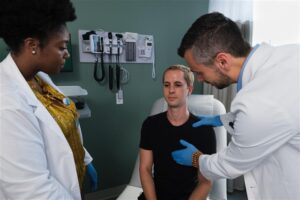The dangers of long-distance travel

By Dr. Henry Ddungu, medical expert and spokesperson for the World Thrombosis Day (WTD) campaign
Millions of people travel long distances each year. And while long-haul travel can be tiring and uncomfortable, did you know it can be harmful for your health, too?
People often sit in cramped and confined conditions for hours at a time when travelling far distances by car, bus, plane, or train. But, warn medical experts, prolonged periods of inactivity can be dangerous, as it raises the risk of blood clot formation, a condition known as deep vein thrombosis (DVT).
“When our bodies stay in a static position for a lengthy period, our blood circulation slows down, leading to blood pooling in the veins of the lower extremities of the body,” explains Dr. Henry Ddungu a medical expert and spokesperson for the World Thrombosis Day (WTD) campaign. “This can cause a blood clot to form in your calves. If the clot breaks loose, it may travel to the lungs, which can be fatal.”
If the vehicle you’re travelling in is packed with passengers, there may be no room to stretch your legs out. The driver may also be on a rigid schedule, meaning limited bathroom stops and opportunities to take a short walk.
Who is at risk?
“Although prolonged immobility is bad for everyone, specific pre-existing factors could increase the risk,” says Dr. Ddungu. “Individuals with a history of blood clotting disorders, who are elderly or obese, who have recently had surgery, or who have a leg cast with limited mobility, are at a higher risk. Pregnancy, or up to three months after giving birth, places women at a higher chance of getting a thrombosis, too.”
Going back home after giving birth or having had surgery, so that loved ones can take care of you is understandable but be aware of the thrombosis risk that come with long distance travelling. If you have a history of blood clotting disorders, consult with your healthcare provider before travelling. In some cases, you might be prescribed blood-thinning medication to reduce the risk.
You could also consider wearing graduated compression stockings to help improve blood circulation.
Before your trip
Prior to your trip, engage in regular physical activity to improve overall circulation and strengthen your muscles. Maintain a diet rich in fruits, vegetables, and whole grains and avoid excessive salt intake, as it can contribute to fluid retention. Smoking can also increase the risk of blood clot formation, so it’s best to avoid it before and during your travel.
During the trip
When your legs remain still for hours, your calf muscles don’t contract, which normally helps the blood circulate. Having to cope with tight legroom and restricted movement is tricky, but there are preventive measures to take, advises Dr. Ddungu. “Wear loose-fitting clothing and once seated, remove your shoes. Avoid crossing your legs – this can impede blood flow, so keep your legs uncrossed while seated.
“Adjust your seating position regularly to improve circulation, and if possible, use pillows or cushions to provide support and comfort. During the trip, move your legs frequently, flexing your ankles and knees. In a bus, consider standing up and stretching in the aisle. When you do stop for a break, stretch your body, and walk around for a bit before you sit down again,” he says.
Another good tip is to drink plenty of water to maintain proper blood viscosity. Hot, dry weather and inadequate fluid intake can lead to dehydration, which can thicken the blood and contribute to clot formation. Limit alcohol and caffeine intake, as they can contribute to dehydration.
Warning signs
According to the WTD campaign, one in four people in the world are dying from conditions caused by thrombosis, but knowing blood clot signs and symptoms can help you spot or prevent blood clots. The most common symptoms of DVT in long distance travel are usually swelling or pain in the leg or arm, skin that is warm and tender to touch, or redness of the skin. Keep an eye out for anything irregular even after the trip has ended, as blood clots can still develop for up to two to four week following long haul travel.
Remember that these preventive measures are general recommendations and may not be suitable for everyone. If you have specific health concerns or conditions, consult with a healthcare professional before embarking on a trip to find out if you are at risk of getting blood clots and if it is safe for you to travel a long distance.







